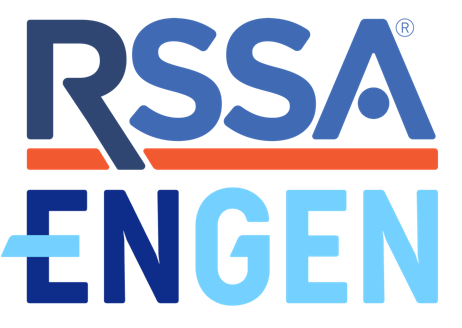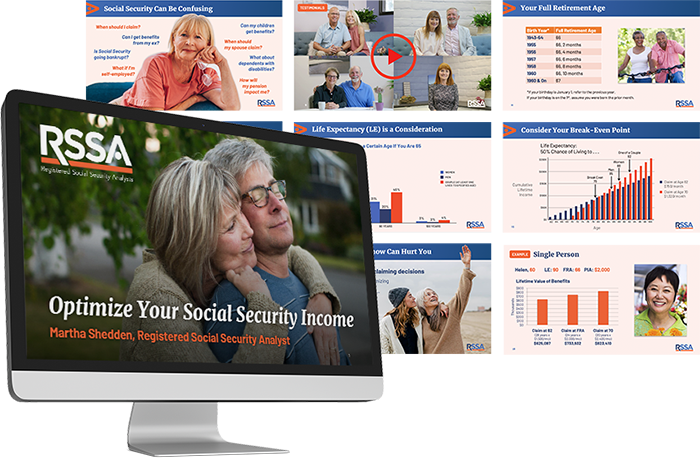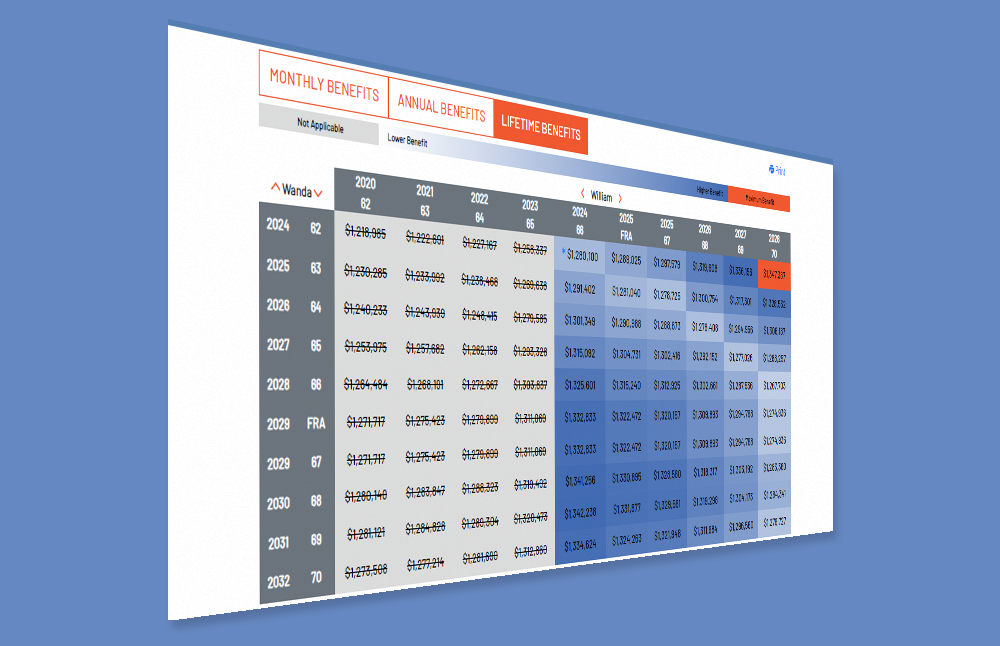Watch This Video To See How It Works

What is the RSSA® EnGen Program?
The RSSA® EnGen Program is a turn-key English instruction program using the RSSA Social Security education, technology, marketing, and support to help you learn English while learning how to become a Social Security expert.
The RSSA Program will teach you how to help clients maximize their Social Security benefits, and you’ll learn how to grow a book of business by building a sales funnel, filling seats at events, and opening the door to organic sales opportunities.
Benefits of the RSSA EnGen Program
Empower the future by serving the underserved. Join the RSSA EnGen Program to unlock your potential, engage the Latino community, and drive impactful change. Upskill with industry-leading English instruction and become a Social Security expert.
- Empowerment through Bilingual Education: Enhance your skills with AI-powered, industry-aligned English instruction while learning to become a Social Security expert.
- Unlock Career Potential: Open doors to new career opportunities by building a pipeline of empowered bilingual agents who can effectively serve the Latino community.
- Boost Employee Recruitment and Retention: Improve your agency’s recruitment, retention, and engagement by investing in the professional development of your employees.
- Serve the Underserved: Address the drastic need in the Latino community, which represents a significant portion of the underserved population in the U.S.
- Turn-Key Solution: Utilize a comprehensive program that combines education, technology, marketing, and support to help you grow your business and maximize your clients’ Social Security benefits.
Transform your agency and empower the Latino community with the RSSA EnGen Program. Join us in creating a more inclusive future—start today!
Request More Information
Here's What You'll Get
The RSSA EnGen Program delivers personalized, career-aligned, mobile-first English instruction. This program will provide you with the English and career readiness skills you need to improve your economic prospects and workplace productivity, and a dedicated learning coach will help you get started and reach your learning goals. Key benefits of the RSSA EnGen Program include:
A Professional Opportunity
Until now, the only option for Social Security guidance was the Social Security Administration, a federal agency that legally is not allowed nor equipped to provide professional Social Security advisory support. For most of these 73 million baby-boomers, Social Security represents a significant portion of their future retirement income.
Most Americans do not understand the complex rules, have questions, and need help deciding when to file based upon their unique circumstance. According to a study by one of the largest insurance providers, over 90% of those currently collecting Social Security have failed to maximize their benefits.
Yet, even most financial service professionals including CPAs, tax professionals, insurance agents and registered investment advisors, don’t have the training or expertise to help their clients, and know very little about the program and its complicated rules. For this reason, they too are sending their clients to the Social Security Administration. This is where RSSA has been a game changer for professionals and consumers.

Everything You'll Need For Success
The RSSA Program includes the 5-module education course, RSSA Roadmap software, and also includes marketing materials, presentations, scripts, and more. RSSA Roadmap software is our proprietary Social Security optimization software. The software and software training are included in the program. You can use this software to run analyses to optimize your clients’ benefits.
Throughout the education, you’ll have access to an in-house support team of RSSAs for education, case, and software support to help you successfully pass the RSSA Final Exam. Once you become an RSSA, you have access to the same in-house team for all the above plus assistance with client cases and much more. Support is central to the RSSA Program.


Earn Your RSSA® Certificate
The RSSA® credential is the standard of excellence in Social Security advisory and planning. As a Registered Social Security Analyst®, you will help clients potentially gain tens or hundreds of thousands of dollars in incremental Social Security income. Take advantage of this smart opportunity and get started with your education and software training today.
With hundreds (and sometimes thousands) of filing options, getting the most from Social Security can be a complex decision. As a Registered Social Security Analyst, you can help you answer common retirement questions like:
- When is the best time to claim?
- Can I get benefits from my ex?
- What should I do if I’m self-employed?
- What about dependents with disabilities?
- How will my pension impact my benefits?
- And so much more…
Professional Continuing Education
The mission of NARSSA is to provide financial professionals and advisors with an educational online platform to acquire the knowledge, obtain a professional credential that demonstrates their competency, and provide professionals with the resources and technology they need to better serve clients that seek advice on issues related to Social Security and Medicare.
The RSSA® program is approved for professional continuing education by NASBA for the CPA Profession, the IRS for tax professionals, the CFP® Board for Certified Financial Planners, Broadridge for the AIF® credential and state insurance licensing boards nationwide. NARSSA is listed in the FINRA Compliance Vendor Directory and materials have been FINRA reviewed. The RSSA® credential is also included in the FINRA Professional Designations Database. (Note: FINRA does not approve or endorse any professional credential or designation.)


RSSA Roadmap® Software
The RSSA® Program is the only program where you will receive RSSA Roadmap® Social Security software, the training to use the software, and the education to become a Social Security expert. This program will teach you how to use software to analyze and provide comprehensive reporting that will help your clients maximize their Social Security benefits.
Develop Core Competency in Social Security
The online self-study courses cover spousal and family benefits, claiming strategies, government pension offset, windfall elimination provision, acronym definitions including PIA and FRA, retirement income taxation, survivor and disability benefits, delayed retirement benefits, Medicare Part A and Part B, when and what to file.
Module I. Social Security Basics
This first module will provide you with detailed basic Social Security information that pertains to all retirees, including a history of the Social Security program, how funding works and how benefits are calculated, descriptions of benefits available for married, single, divorced and widowed retirees, and critical information to consider when evaluating the election claiming decision. Case examples will be used to illustrate the most commonly used rules and strategies needed to optimize Social Security benefits through the comparison of best versus worst claiming decisions.
- Learning Objectives
- Identify the effect of life expectancy on lifetime Social Security income amounts and survivor benefits using a given couples’ case example.
- Specify the steps used to calculate a retiree’s social security benefits.
- Select the correct amount of annual decrease or increase in Social Security benefits for retirees who claim prior to their full retirement age or after that date.
- Identify the current year earnings test income limits and the amount of Social Security benefits to be withheld given a retiree’s age and earnings.
- Recognize the rules and requirements for retirees to collect spousal and survivor benefits.
- Specify the factors that determine eligibility for domestic partners to collect Social Security under the spousal rules.
Module II: Social Security Advanced Topics
The topics covered in this module allow you to provide accurate, in-depth advice when offering Social Security advice to a broad base of clients. The Social Security claiming decision is often more complex for retirees who have special situations such as minor children, a dependent parent, a disabled adult child, or a pension from non-covered employment. Module II covers family maximum benefits, factors that make the benefit claiming decision so important for women, and the two pension related rules. You’ll also learn about how much of a retiree’s Social Security income will be taxed and case studies illustrating the need for education and retirement planning to include and manage this taxation. You’ll learn about Social Security disability, including the general rules, eligibility criteria, and family disability benefits. Module II concludes with a discussion of the future of the Social Security program.
- Learning Objectives
- Specify which family members are eligible to collect Social Security benefits based on a worker’s earnings.
- Calculate how much individual family members may collect in Social Security
- benefits based on the Family Maximum Benefit rules.
- Understand the combined income thresholds for single and married taxpayers and the portion of their Social Security income that may be subject to taxation.
- Understand the steps used to determine eligibility to receive disability benefits.
- Identify the factors that support the need for women to fully understand their Social Security benefits and claiming choices.
- Recognize possible future adjustments to the Social Security program that will help the trust fund to remain solvent.
Module III: Bridging to Retirement Planning
Planning to retire requires a major shift, from years of working and accumulating wealth to relying on that nest egg and other sources of income for the retirement years. This module teaches you to make smart Social Security decisions in the context of other retirement finances. You’ll learn about the elements of retirement planning such as gathering, reviewing and assessing all retirement financial information, income, assets and expenses, as well as understanding your clients’ lifestyle, goals, expectations. You’ll learn a process to guide clients on setting goals that takes into account their tax liability, medical, insurance, legal and legacy planning that will allow them to achieve the retirement they desire. You’ll learn about the importance of Social Security tax management in the context of overall retirement planning and see case studies that illustrate the tax implications. And because Social Security and Medicare are very interconnected, you’ll also get an introduction to Medicare, eligibility requirements, benefits, what Medigap, or supplemental insurance plans, are available, and the Medicare application process.
- Learning Objectives
- Differentiate between the funds in a retirement planning “stool” versus a retirement planning “pyramid.”
- Recognize how Social Security taxation and income planning in a comprehensive retirement plan can increase the longevity of portfolios.
- Recognize the difference between optimization and maximization of Social Security benefits.
- Understand how the timing of claiming Social Security benefits and the sequence of the retirement account and other asset withdrawals can impact retirement finances.
- Determine the impact that claiming Social Security at certain ages can have on total taxable income and taxation of benefits.
- Understand the four Medicare parts, eligibility and work requirements, and benefits, and how premiums are calculated.
Module IV: Working with Clients
Working with clients to analyze their optimal Social Security claiming decisions can be approached in a very systematic way. The process itself is straight-forward, following a detailed set of steps and requiring specific software inputs.
The value you provide is the detailed knowledge of Social Security rules and claiming nuances to know the correct questions to ask your clients and guide them in their decision. Making sure that a client’s personal past, current, and future circumstances are considered will guarantee that you are working towards their optimal claiming decision. Whether you will be offering this service as a stand-alone analysis and report or including it in the larger retirement financial planning service you offer clients, the desired result is the same – helping them to make an optimal claiming decision to guarantee they receive all they are entitled to.
Chapter 1 covers the Social Security income planning environment, what the current and future market is for this service, and how any upcoming proposed changes to the Social Security program will impact the need. Opportunities for building and incorporating Social Security services into an existing business are discussed.
Chapter 2 is an introduction to working with clients including assessing their needs and gathering the critical information needed for the Social Security analysis. The Social Security claiming decision can lead to an examination of other retirement finances, providing an analyst with further opportunities to work with clients on their retirement financial plans and grow their business. Chapter 2 concludes with a discussion about of presenting and explaining the analysis and report to clients.
Chapter 3 describes and specifically addresses the unique opportunity to help self-employed business owner clients who are nearing retirement. Sections include explanations of the major business structures, self-employment taxes, earnings and deductions, and how net earnings are determined and reported.
Chapter 4 introduces a unique service opportunity, the Self-Employed Tax and Retirement Analysis (SETARA). This analysis is Social Security based and provides comparisons of alternative projected client incomes and the resulting effect on their lifetime benefits and amount of self-employed tax contributions. A detailed client case is presented to show potential savings and resulting additional income.
Module V: RSSA Roadmap® Social Security Software Case Studies
The knowledge you learned in the first four modules will be applied to real-world case studies. In this final module, you will learn to use the RSSA Roadmap® Social Security software to examine various “What-If” strategies based on different claiming ages and see side-by-side comparisons that allows you to show clients the difference in amounts of lifetime, annual, and survivor income benefits. You’ll also be introduced to sample people who have special Social Security claiming cases including:
Mark Hamill, who is single and will be receiving a non-covered pension in addition to his Social Security benefits. This case highlights the changes to Mark’s Social Security benefit due to the Windfall Elimination Provision (WEP).
Robert and Sarah Marsh, a married couple, who have an adult disabled son Greg. Their case is complex since their son is also eligible for benefits when they start collecting their retirement benefits.
Julie Woods, a single woman who was married for over 20 years and has been divorced for about ten years. This case involves an ex-spousal benefit.
Thomas, a self-employed attorney has the option to take his compensation as a salary or as a distribution from the company. At age 60, he is wondering how these options will affect his Social Security benefits and survivor benefits for his wife.
- Learning Objectives
- Recognize the reason(s) estimating maximum life expectancy is important when deciding which age to start claiming Social Security benefits.
- Recall how collecting a non-covered pension can affect a retiree’s Social
- Security retirement, spousal, and survivor benefits.
- Select the Social Security rule(s) that determine if an adult disabled child is eligible for Social Security benefits.
- Choose the requirement(s) that divorced retirees must meet to be eligible to collect an ex-spousal benefit.
- Recognize the conditions that a retiree must meet to be eligible to use the “restricted application” claiming strategy.
- Estimate the difference in lifetime benefit amounts between the maximized and the default alternative filing age for married and divorced couples.
- Recognize the Social Security claiming factors that a self-employed owner and sole shareholder of a corporation must consider.
Before you can take the RSSA Final Exam, you must first pass all five self-study modules which must be taken in a specific order. The modules are designed so that you can study and pass them at your own pace. It is estimated it will take you 15-25 hours to take these modules. Each module is divided into chapters. You must take the chapters in order. Each chapter will have practice questions, which you must answer.
Next Steps!
Watch this video to learn how to get started.

